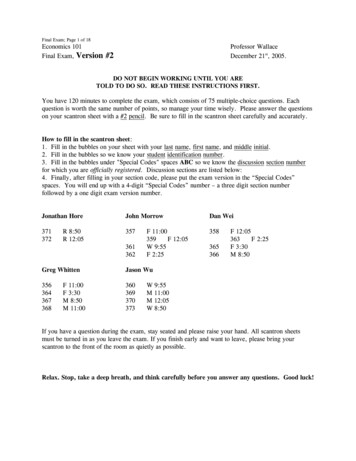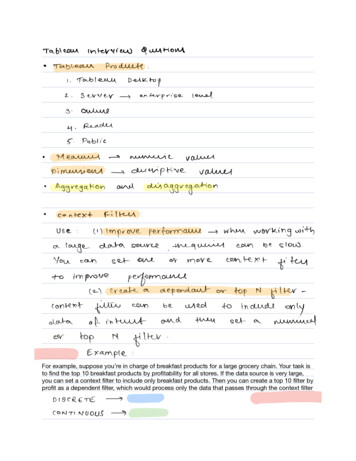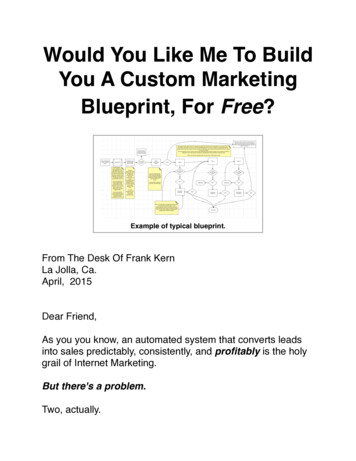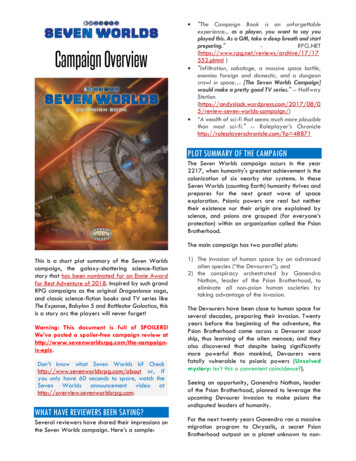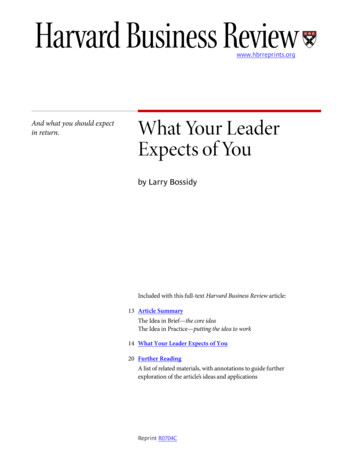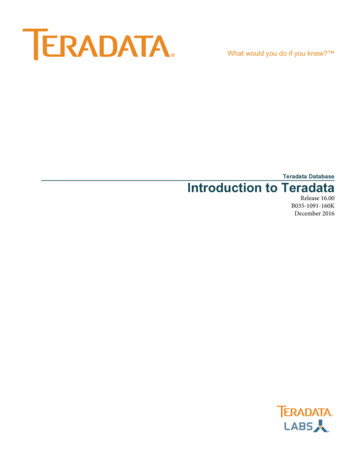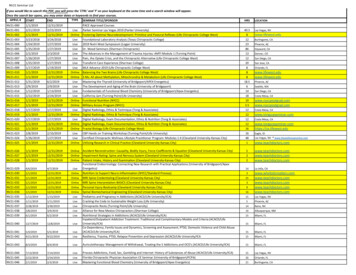
Transcription
December 2, 2015Emerging Theme RadarWhat if I Told You Equity ResearchThemes, Dreams and Flying MachinesWhat if I Told You Seven For SevenThat as the terms innovation and disruptionbecome mainstream there are still pockets ofdiscovery value for investors in the world today.From curing cancer with the cloud to solvingspace to creating an alternative to fossil fuel inlithium, opportunities abound for those willing tolook beyond today’s headlines. The world ischanging as a new generation (Gen-Z) is poisedto take the mantle from Millennials while thepayback for college becomes harder to justify.(1) The Blockchain Could Disrupt Everything.This is all in the face of a market that remainsvolatile with the potential for another flash crashlooming. Meanwhile, while the Bitcoin hype cyclehas gone quiet, Silicon Valley and Wall Street arebetting that the underlying technology behind it,the Blockchain, can change well everything. Itis against that backdrop that we present our latestdepartmental thematic piece focused on sevenkey emerging debates we believe need to be oninvestors’ radars. This 7 for 7 offers up insights onthese key stories with a focus on framing aresponse to What if I Told You?Potential use cases for the core technology behindBitcoin abound. The VC backdrop is healthy andexpectations are high, but roadblocks remain.(2) Space is Once Again the New Frontier. Thespace race is reigniting, and we see investmentopportunities.Robert D. Boroujerdi(212) 902-9158 robert.boroujerdi@gs.comGoldman, Sachs & Co.Christopher Wolf, CFA(212) 934-4221 christopher.wolf@gs.comGoldman, Sachs & Co.(3) College May Not Be Worth It. The averagereturn on going to college is falling, and for somethe cost may no longer be justified.(4) Gen-Z Matters More than Millennials.America’s youngest cohort will soon overshadowtheir predecessors in size and influence.(5) There will be another Flash Crash. The Aug24th selloff exposed the flaws of a market whereregulation is not uniform across the exchanges.(6) Lithium is the New Gasoline. Lithium’sunique properties make it a key enabler of theelectric vehicle revolution.(7) The Cloud Can Help Cure Cancer. For the firsttime in history, physicians will have the ability touse genomic profiling for every cancer patient.Goldman Sachs does and seeks to do business with companies covered in its research reports. As a result, investors should be aware that the firm may have aconflict of interest that could affect the objectivity of this report. Investors should consider this report as only a single factor in making their investment decision.For Reg AC certification and other important disclosures, see the Disclosure Appendix, or go to www.gs.com/research/hedge.html. Analysts employed by non-USaffiliates are not registered/qualified as research analysts with FINRA in the U.S.The Goldman Sachs Group, Inc.Global Investment Research
December 2, 2015AmericasTable of ContentsWhat if I Told You the Blockchain Could Disrupt Everything3What if I Told You Space Is Once Again the New Frontier6What if I Told You College May not Be Worth it?9What if I Told You “Gen-Z” Will Be Larger and More Influential than Millennials11What If I Told You August 24th Won’t Be the Last Flash Crash13What if I Told You Lithium is the New Gasoline16What if I Told You the Cloud Can Help Cure Cancer19Disclosure Appendix23This is an abridged version of a report published Dec. 2, 2015. All investment recommendations have been removed.Analyst Team Contributors:Robert D. BoroujerdiNoah Poponak, CFAHugo Scott-GallChristopher Wolf, 158212-357-0954212-902-0159212-934-4221Goldman, Sachs & Co.Goldman, Sachs & Co.Goldman, Sachs & Co.Goldman, Sachs & Co.Katherine FogerteyRobert Koort, CFABrian Maguire, CFAIsaac -8480713-654-8483212-902-6393Goldman, Sachs & Co.Goldman, Sachs & Co.Goldman, Sachs & Co.Goldman, Sachs & Co.Goldman Sachs Global Investment Research2
December 2, 2015AmericasWhat if I Told You the Blockchain Could Disrupt EverythingFrom Silicon Valley to Wall Street, technologists and investors alike are buzzing about the potential for the Blockchain torevolutionize well everything. The hype is high and the potential is real but roadblocks remain. The funding backdrop ishealthy and the application eco-system is growing. Once considered the underlying pipes of Bitcoin, this technology isquickly taking center stage from its crypto-currency parent promising an ushering in of a new set of tools to cut costs andchallenge the profit pool of the middle-man with a promise to make centralized institutions obsolete. This solutionpromises to not just address consumer opportunities but also those for the far more lucrative enterprise.What if I told you that Bitcoin was just the opening act with the Blockchain ready to take center stage. In its purest formthe Blockchain is a digital platform that records and verifies transactions in a tamper- and revision-proof way that is public to all(Exhibit 1). Levering the same peer-to-peer technology first developed in a dorm room at Northeastern University with Napster (andsubsequently built upon by folks like Skype and Spotify) the tool was first born out of a need to track and create Bitcoin. SpecificallyBitcoin and other cryptocurrencies required a way of building agreement between all parties involved in a transaction. From buyingto selling to trading to storing, every transaction would be chained to each other so one could never duplicate or change theownership of Bitcoin. This Blockchain allows information to be put in, but never deleted. This complete history a “shared publicledger” that a network (and the currency) relies on, if you will - made, in the user’s mind, the role of a Central Bank obsolete (Exhibit2). The fiat of the currency, as a result, was born of the citizens of the internet, not a central clearing institution or agency. Lastly,while the Blockchain associated with Bitcoin remains the most well known, there are growing sets of private and permission-drivenshared ledgers gaining traction and worth focusing on.Exhibit 1: The Blockchain is a distributed, public ledger, most commonlyknown as the core underlying technology for BitcoinExhibit 2: The size of the Blockchain grows along with the no. of transactionsAggregate size of the Bitcoin Blockchain (MB) since inception (2009)60,00050,000Blockchain Size (MB)40,00030,00020,00010,00002009Source: Goldman Sachs Global Investment Research.Goldman Sachs Global Investment Research201020112012201320142015Source: blockchain.info, Goldman Sachs Global Investment Research.3
December 2, 2015Americas The Role of Cryptography. Before any transaction is approved and added to the Blockchain it is verified by an algorithm thatleverages cryptography to verify its authenticity. Each transaction that occurs in Bitcoin, for instance, has the information sentout across the network for trust and verification. By solving the algorithmic riddle behind putting a block of transactionstogether, individuals or groups, known as miners, receive a reward. That of more Bitcoins. This process, distributed acrossmultiple nodes across a network, is complex, large-scale and incredibly hard to do. Persistent and reliable, in this systemeveryone has to agree to a transaction yet no one owns it. It allows people who don’t know each other, or trust each other, tocome to an agreement that is validated, trusted and held as a matter of public record. Wait, I Thought Bitcoin was dead? Granted, over the last two years ending November 30, the price of Bitcoin has fallen 67%to 377 and fluctuated materially as highly publicized scandals involving digital properties such as Mt. Gox and Silk Roadbecame mainstream fodder and global economies stabilized thus reducing the lack of confidence in central institutions. Add tothis mystery of Satoshi Nakamoto, the pseudonym of a person or group who created the Bitcoin protocol and related software.Regardless, those who wrote off Bitcoin may have missed the golden egg – an underlying technology driver aimed atstreamlining, potentially, a multitude of businesses. Put simply, the Blockchain can live outside a world of Bitcoin.Why It Matters? This decentralized, cryptography-based solution cuts out the middle man. It has the potential to redefinetransactions and the back office of a multitude of different industries. From banking and payments to notaries to voting systems tovehicle registrations to wire fees to gun checks to academic records to trade settlement to cataloguing ownership of works of art, adistributed shared ledger has the potential to make interactions quicker, less-expensive and safer. By removing the need for amiddle man one lowers potential security concerns from hacking to corruption as well as speeding up manual processes that areantiquated and can take too long. Your counterparty risk, if processing times improve, can be near instantaneous, allowing accurate,in real-time, feedback on risks and exposures. In the world of the author, think of it from the banking side. In the face of increasedcapital and regulatory costs, any incremental technology that improves ROI drops to the profit line. Supervisory and technologyresources as a result, could be cut.What are the Drawbacks?Like any new technology, the hype cycle is building with no real, at this point in time, legislative or regulatory framework. Opensource has a history of both successes and failures, thus begging the question of how open or controlled Blockchains will be. That’snot to say private Blockchains can’t work but fragmentation may slow adoption. Further, as with any solutions tied to technology,the key questions about the cost of development and maintenance become profound and core to scalability (as does speed). In thecase of Bitcoin, for instance, VisaNet, (Visa’s processing system), stated in 2013 that it could handle 47 K transactions per second (atcapacity) where the Bitcoin Blockchain handles roughly 7. This is because Bitcoin software limits the size of each block to 1 MB(today, due to network compute concerns), which is created every 10 minutes. Each transaction varies in size but the smallest blocksize is 224 bytes so a 1024 KB block/256 bytes 4,096 transactions every 600 seconds which equates to 7 a second.Goldman Sachs Global Investment Research4
December 2, 2015AmericasExhibit 3: Venture Capital Funding has grown exponentiallyExhibit 4: Bitcoin transaction volumes continue to growBitcoin / Blockchain VC funding by year ( , mn)Total number of unique Bitcoin transactions per day300,000600 482500400VC Funding byYear ( , mn)250,000200,000Number of Transactions per Day 362150,000300100,00020050,000 95100 20200902012201320142010201120122013201420152015 YTDSource: CoinDesk, Goldman Sachs Global Investment Research.Source: blockchain.info, Goldman Sachs Global Investment Research.Outside the Start-Ups, Examples of Use Cases The bevy of start-ups in this space are not small. From Digital Asset Holdings to Coinbase to Ripple to Ethereum (among manyothers) the list is long. For the purposes of this presentation we showcase three emerging applications to highlight the potentialrange of usage forming in corporate America today.R3CEV. A consortium of 30 of the largest global banks this body is working to establish clear standards and protocols for distributeddatabase activities. This New York based start-up has hired from Google, IBM, Barclays and others to help reduce costs in banking.ADEPT. Merging IoT with the Blockchain, IBM and Samsung have developed ADEPT, or Autonomous Decentralized Peer to PeerTelemetry, which aims to leverage technology to help serve as ledgers or record-keepers for all the transactions that IoT activitieswill create. It can also be used to as a way for devices to understand how others work (think of linking your phone with your homeheating system). This technology also borrows from BitTorrent and Telehash with promise to improve security concerns as well(another area of focus for the Blockchain).Nasdaq. Has launched Nasdaq Linq, its Blockchain-enabled platform used to facilitate the issuance, cataloguing and recording oftransfers of privately held companies on the NASDAQ private market. Nasdaq partnered with Chain.com leveraging its own inhouse IP.Goldman Sachs Global Investment Research5
December 2, 2015AmericasWhat if I Told You Space Is Once Again the New FrontierThe space race is reigniting and we see investment opportunities. As the barrier and costs to deploying space technologiesare lowered, we believe A&D companies will see accelerated growth in their space business lines, while commercialsatellite operators may be disrupted by lower-cost alternatives. Escalating geopolitical tensions appear to be driving the UStowards increased militarization of space and protection of existing assets, with growth in funding in space asset protectionas a result. Space is becoming smaller, closer, and cheaper, reinventing an industry that has stagnated for decades andmaking room for new applications, technologies, and competitors.What if I told you that space launches now cost 11X less than 5 years ago and that satellites can cost 100X less. Our ability toget to space has changed more in the last 5 years than during the entire prior period of space exploration. The new accessibility mayradically change our activities in space. Low-cost launches allow for deployment of low-cost satellites with shorter life expectancies,lowering the barrier for commercial, military, and scientific space activities. Constellations of smaller satellites can now do the workof older satellites at significant cost savings. Without this high barrier to entry, the space economy may undergo an era of creativedestruction. Satellite manufacturers and la
Goldman, Sachs & Co. Christopher Wolf, CFA (212) 934-4221 christopher.wolf@gs.com Goldman, Sachs & Co. Goldman Sachs does and seeks to do business with companies covered in its research reports. As a result, investors should be aware that the firm may have a conflict of interest that could affect the objectivity of this report. Investors should .File Size: 989KBPage Count: 25
